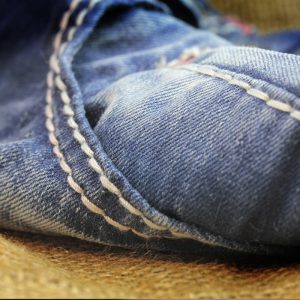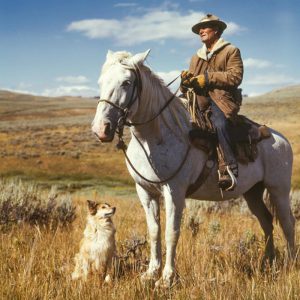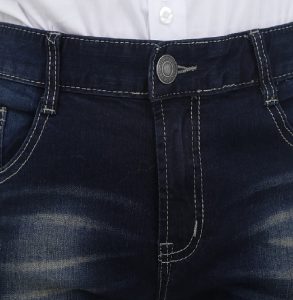What is Denim and what is it made from?
Denim is a sturdy cotton twill fabric, generally used to make garments such as jeans, dungarees and other clothing. It is typically blue in colour. However, it can have a multitude of different finishes such as being stonewashed, striped, faded, napped and indigo. Traditionally it is created from 100% cotton yarn. Today this fabric is often blended with polyester to prevent wrinkles and control shrinkage when washing.

How is it made?
So, you might be wondering – what is denim made from exactly that gives it that unique, sturdy texture? Part of what gives it its signature feel is the way it’s created rather than the just materials it’s created from. Denim fabric is made by creating a tightly woven twill. Twill is a type of weave with a pattern of diagonal parallel ribs to create a rugged and strong fabric. Horizontal threads of cotton (known as the weft) are passed under two or more vertical threads (known as warps). This results in a diagonal ribbing which characterizes denim and sets it apart from other cotton fabrics.
Indigo denim is the most common type. The warp threads are dyed a deep blue and the weft threads are left white. This results in the faded characteristic that this fabric is synonymous with. One face of the fabric ends up being dark blue and the other side is left white. That’s why blue jeans are usually lighter or white on the inside. The yarns have a very strong twist to make the fabric more durable. When they’re dyed only the outer yarns pick up the dye which leaves the core white. This white thread at the centre creates the typical fading feature of denim which we’re familiar with.

What is Denim used for?
A pretty obvious one, but the most popular use for denim is for jeans, jackets and dungarees. With certain types such as Bull denim it is also used for upholstery or homeware. The durable quality of the fabric meant that denim jeans were originally worn by miners and even soldiers whilst they were on leave, before they gradually began being worn purely for fashion or comfort purposes.
Its origins: the beginning of a new ara
‘Denim’ originates from the name of a French town, Nimes, where this fabric was first created. ‘De Nimes’ literally translates as ‘of Nimes’. When the weavers of Nimes attempted to reproduce cotton corduroy that was famously created in Genoa, Italy without any luck. After much experimentation, they were unable to produce the corduroy. However. they came up with the classic denim fabric which we’ve embraced to this day.
Jeans are actually named after Genoa, where this corduroy was called jean or jeane. The term jeans initially referred to trousers created from this cotton fabric. But after being adopted by Levi Strauss it became synonymous with denim. Strauss (a businessman) and Jacob Davis (a tailor) aimed to create sturdy trousers for miners during the American Gold Rush. Denim was perfect for this. The duo used rivets to reinforce parts of the garments that tended to rip. Modern jeans still often feature rivets today.

The Denim rebellion
Particularly in America, the popularity of denim surged during the 1930’s after the introduction of cowboy films from Hollywood. Vogue even ran an ad campaign in a 1930 issue. It showed two women in fitted jeans which they branded as ‘Western Chic’. However, jeans were only specifically designed for women from 1958. Throughout the 50’s, denim fashion continued. It was particularly inspired by the 1953 Marlon Brando film ‘The Wild One’ and James Dean movies, showing rebellious youths in jeans and leather jackets. Jeans became a sign of rebellion. Some schools or public places even banned the wearing of jeans because of what they had come to represent. Counter-culture youth who protested the establishment opted to wear jeans to illustrate their solidarity with the working classes.
It was only in the 60’s and 70’s that denim became mainstream fashion. Popular brands like Levi’s began to experiment with new styles of jeans. The manufacturing process had begun improving, and blue jeans became a staple for most people at the time.

Dry vs. washed
These days, most denim clothing have been pre-washed to soften up the fabric. This makes it more comfortable to wear, and prevents the indigo dye rubbing off. Dry or raw denim has simply not been washed after being dyed. As a result, it has a stiffer and heavier feel.
Dry denim will fade with wear creating that classic vintage look. Fading generally occurs wherever the fabric receives the most stress. For example, on jeans this is usually the knees and the thighs but it depends on the wearers daily activities. Washed denim is often artificially stressed to create that fashionable faded look, to resemble traditional dry denim. Some people are not keen on the artificially faded look. It doesn’t bear the ‘natural’ element of true raw denim. Some wearers don’t wash their jeans until they’ve worn them for around six months, to ensure they ‘distress’ naturally!
Those fashionable fades even have their own names depending on the pattern, and give your jeans a personal touch. Denim enthusiasts experiment with unique fades through a variety of techniques to create an original look.
Four Great Fades on Jeans
- Whiskers – Streaks that stretch out from the crotch area
- Honeycomb – Faded lines that form behind the knees
- Train Tracks – A faded pattern that forms along the out-seams of the fabric by forming two parallel lines.
- Stacks – This occurs when the jeans are longer than the leg length. The fabric stacks up around the top of the shoe, which then rubs and creates a faded area.

Other Types of Denim
- Stretch or Bubblegum Denim: this type contains lycra or spandex to give them an extra stretchy quality; perfect for skinny jeans or jeggings.
- Bull Denim: is dyed after being woven. It has a more uniform appearance than typical denim where the threads are dyed before being woven. It also has a distinctive diagonal weave.
- Reverse Denim: A slightly more unusual look. These jeans are made from reversed denim to give them a different appearance with the whiter part of the fabric on the outside.
- Ring Denim: This traditional type of denim is created using ring-spun yarn for the warp. This results in a softer fabric with an uneven surface texture.
- Marble Denim (or acid wash): To create that signature acid wash look, the fabric is strongly bleached to create a mottled design.
- Fox Fibre Denim: Sally Fox, a Californian cotton breeder, grows natural coloured cotton fibre which has been manufactured into denim to create uniquely coloured – but totally natural – jeans.
- Over Twisted Denim: The yarn is over twisted prior to being woven, giving the fabric a crinkled surface texture.
Print Your Own
Denim which has been printed with various patterns or colours for decades; mostly for jackets or jeans for a bright and vibrant look.
Why not try designing your own denim fabric? With so many different varieties available, you can even order test prints to see which one you prefer. What’s more? You’ll get a £10 voucher towards your first fabric print order, as well as experiencing how easy it is to design your own fabric.
Explore this fabric and over 100 others in your own swatch pack.



Thanks for this blog…After reading this blog, I get to know about the history of Denim..origin of Denim fabric and many more useful things about it…I really love it…So informative and interesting blog